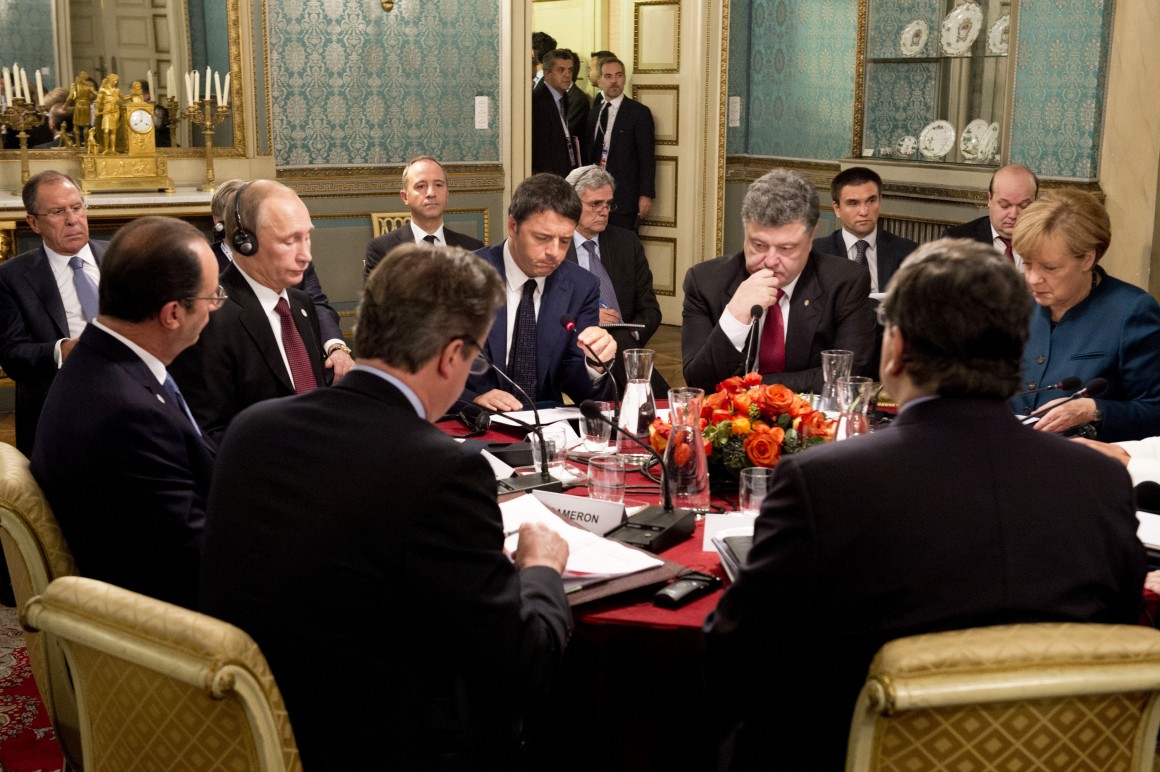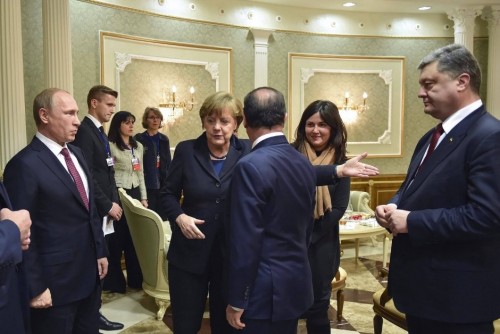In a post-Soviet republic, separatist militants attacked government buildings in a regional capital and proclaimed independence. The central government responded by mobilizing its security forces and attempting to retake the restive region. Undermanned and their strength a far cry from the might of the Soviet Army of which they were once a part, government forces performed poorly and filled manpower needs from questionable sources.
So-called “volunteers” from Russia eagerly joined the separatists’ ranks. The separatist forces acquired heavy arms from the Russian military, while the government’s Ministry of Defense directly accused Russian forces of engaging in the conflict directly. Officially, Moscow proclaimed neutrality, denied any involvement beyond its citizens joining as “volunteers,” and urged negotiations. Under mediation from other post-Soviet states, the sides met and negotiated ceasefires that fell apart. The fighting claimed thousands of lives and devastated cities in the region.
The conflict just described is not the ongoing war in Eastern Ukraine’s Donbas region but the War in Abhazia between the Georgian government and Abkhazian rebels, which lasted from 1992 to 1993. This was but one of many ethnic conflicts that erupted in the successor states of the Soviet Union after its collapse in 1991. All told, wars in the former Soviet republics of Georgia, Tajikistan, Moldova, Russia, Armenia, and Azerbaijan in the 1990s claimed hundreds of thousands of lives and uprooted millions.
These wars did not end with the twentieth century either. Most have resulted in rebels controlling a swath of territory organized into an unrecognized but de facto state. In some cases Russian military forces station themselves as “peacekeepers” in those zones. Their presence in the breakaway Abkhazia and South Ossetia regions in Georgia in part sparked the 2008 Russo-Georgian War, a quick rout of Georgian forces that confirmed the de facto independence of those regions and how far Russia was willing to go to back it.
The conflict in Donbas, the industrial region in Eastern Ukraine comprised of parts of the Donetsk, Lugansk, and Dnepropetrovsk provinces, resembles the other ongoing or frozen conflicts around the wreckage of the USSR. While it lacks the long-simmering ethnic conflict dimensions of many of the wars, the similarities to conflicts like the Abkhazian war are remarkable. The Georgian military filled manpower needs in early stages of the war by freeing and arming convicts from the nation’s jails. Ukrainian armed forces’ manpower is augmented by multiple paramilitary organizations—often far-right nationalists with views ranging from reactionary to outright neo-Nazi, and often backed by powerful Ukrainian oligarchs. Like their Abkhaz counterparts in Georgia in the 1990s, the Donbas separatists receive weapons, training, and support from the Russian military, and Russian forces appear to be operating actively in the theater in some numbers, although certainly neither openly nor at their full potential strength. What does the outcome of these other conflicts mean for Ukraine?
Looking around on Ukraine’s twenty-fifth Independence Day, the pace of the fighting in Donbas has slowed considerably in the past year, yet a fully implemented ceasefire remains elusive. After Ukrainian forces’ initial debacle during the start of the war in spring 2014, the military reorganized, replenished its manpower, and made steady progress in retaking key separatist strongholds and pushing the pro-Russian forces back almost to the border, until a thinly-veiled Russian intervention at the end of August 2014 threw the Ukrainians back and led to the first Minsk Protocol in September.
The Minsk Protocol was a ceasefire agreement between representatives of Ukraine, Russia, the Organization for Security and Cooperation in Europe (OSCE), and the two separatist republics of Donetsk and Lugansk. After the accord was struck, fighting slowed in Donbas but never really stopped, flaring up again in January and February, which led to a second summit in Minsk that slowed the fighting even further. Yet the fighting continues to this day, with hundreds of Ukrainian soldiers killed in action in Donbas since February. However, there have been little territorial advances made by either side.
There are several cold realities facing Ukraine, an ancient nation and a young state. One is that military conquest over the so-called people’s republics in the east is impossible, barring a total collapse or volte-face in policy of the Russian state. Accusations of impending massive Russian invasions are overblown, but it’s quite clear that the Kremlin will not allow the separatist republics to fall and will intervene as needed to repel any Ukrainian offensives.
Another is the fate of Crimea, which Russia annexed in short order after President Viktor Yanukovych fled Kiev early in 2014, setting the stage for the upheaval in Donbas. Crimea’s fate sparked the first round of sanctions against Russia, yet these were fairly mild sanctions compared to later rounds imposed in response to Russia’s actions in the war. Talk of returning Crimea to Ukraine is a moot point: Russia has indicated that it will defend the peninsula with the full might of its military and nuclear arsenal, and the people of Crimea do seem to favor Russia over Ukraine, although not as much as the much-derided referendum on independence would indicate. Western leaders have almost completely dropped the subject, while even Ukrainian leaders mention it less and less. Crimea is likely to remain a sore subject between Ukraine and Russia, one of many in their already abysmal relations.
While Crimea is now Russian territory, it seems that Moscow has little appetite to similarly annex the Donetsk and Lugansk regions. The 2014 referendum in those territories – an even more risible affair than the Crimean referendum in March of that year – could have given a clear pretext for occupation or an overt peacekeeping mission, but Russian aid to the separatists continued to be under-the-table and officially disavowed, even with active-duty Russian soldiers captured in Ukraine. It also seems that the separatists, for all their bluster, are unable (for now) to push back Ukrainian forces to take the key city of Mariupol, opening a land bridge to Crimea, or to take the entirety of the Donetsk and Lugansk Oblasts (provinces), which are still under Ukrainian control. The situation is shaping up to be yet another frozen conflict on Russia’s borders, which for the time being seems to suit the Kremlin just fine. The Western-leaning government in Kiev has its hands full with the Donbas war, which stymies any attempts at further integration with the European Union or NATO. However, it is hugely ironic that Russia’s hostile actions toward Ukraine since the revolution – ostensibly aimed at preventing NATO membership for Ukraine – has driven Ukrainians to support joining the alliance in higher numbers than ever. According to a recent Pew poll, a slim majority of Ukrainians support joining NATO, although the idea remains contentious and Pew was unable to conduct the polls in Donetsk or Lugansk.
Ukraine now faces the reality of an unfriendly, powerful neighbor propping up hostile forces inside its own territory. With the stalemate more or less in effect, Ukraine must deal with a host of domestic issues while at the same time holding off separatists and one of the most powerful militaries in the world.
There are essentially three outcomes for the country now: stagnation and a return to business as usual in the twenty-sixth most corrupt country in the world, successful reforms and progress (however slight) toward European integration, or collapse and yet another revolution, bringing to power either pro-Russian lackeys or far-right revanchists, either of which would be a catastrophic coda to the Maidan revolution.
The Orange Revolution of 2004 – 2005, which saw massive protests against a rigged election result in a second round and pro-Western Viktor Yuschenko voted in over Yanukovych, failed because its leaders, Yuschenko and Yulia Tymoshenko, failed to deliver any meaningful domestic reforms. The task facing Poroshenko is daunting: over two decades of systemic corruption, a state that is already facing collapse, and a Russia eager to see him fail. Appointing former President of Georgia Mikheil Saakashvili as the governor of the Oblast of Odessa was a bold move that could result in meaningful progress against corruption, but it has also placed a favorite Kremlin punching bag in an area that saw considerable pro-Russian unrest and upheaval, most notably the fire last May that resulted in the deaths of dozens of activists.
If Poroshenko and his team, including Saakashvili, can deliver on political reforms and fight corruption along with economic growth, then they will be taking the first, painful step on a path toward closer integration with Europe. But if they fail, especially if the economy spirals downward, then the state faces a dangerous situation. Such conditions could weaken Ukraine significantly enough for Russian forces – either openly or in the guise of the separatist military – to take large portions of Eastern Ukraine or even Kiev. Even more troubling, it may pave the way for a far-right, neo-fascist party to take power, and Ukraine is not lacking for far-right activists. While the country is not already a fascist junta, as Russian media suggests, familiar faces like Svoboda have been joined by newer, stronger nationalist groups like Pravy Sektor (Right Sector) or the myriad volunteer battalions in Donbas.
These groups filled a role in fighting separatists in the east, but their success and growth is troubling. Last month in Mukachevo, a town on the border with Poland and Slovakia, at least seven people were wounded in a gunfight between Pravy Sektor and Ukrainian authorities, ostensibly connected to gang rivalries over cigarette smuggling into the EU. However, lingering malcontent over the situation in Donbas could spread to these armed, radical groups and lead to attempts at overthrowing the government. This would be a catastrophe. Similarly disastrous would be an attempted overthrow or coup from the pro-Russian side.
The Maidan revolution did not immediately deliver Western governance or living standards to Ukraine, but there has been some tentative, uneven progress toward reform. If Ukraine continues stagnating with no real progress, as it has so often in the post-communist era, then the future is dark. Yet even though the road ahead will not be easy, Ukraine’s long and difficult history has been full of its determined people triumphing over all odds and enemies – from the Mongols to Nazis. If its political leaders possess the courage and will to see difficult reforms through, and the international community supports Ukraine in its hour of need, then Ukraine will eventually triumph yet again, and may even be able to peacefully win back restive Donbas.
Andrew Shell is Managing Editor at the Georgetown Public Policy Review and studying public policy at Georgetown University’s McCourt School. A Georgia native and 2010 graduate of the University of Georgia, he served in the Peace Corps in Ukraine for two years before moving to Washington, DC in 2013 where he currently resides.


1 thought on “24 years into Independence, Ukraine Faces its Greatest Challenge”
Comments are closed.